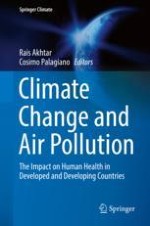2018 | OriginalPaper | Chapter
3. International Conferences on Sustainable Development and Climate from Rio de Janeiro to Paris
Authors : Giovanni De Santis, Claudia Bortone
Published in: Climate Change and Air Pollution
Publisher: Springer International Publishing
Activate our intelligent search to find suitable subject content or patents.
Select sections of text to find matching patents with Artificial Intelligence. powered by
Select sections of text to find additional relevant content using AI-assisted search. powered by
